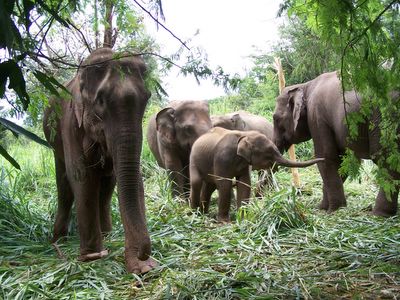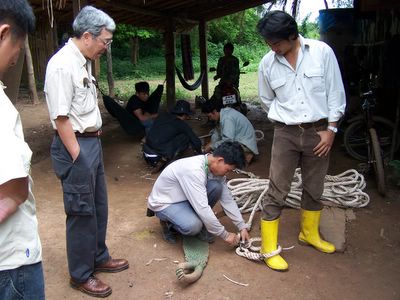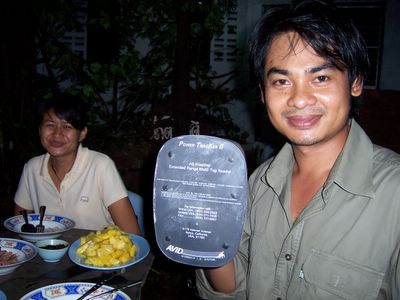Our Mission is to realize the vision of Her Majesty Queen Sirikit, The Queen Mother by reintroducing domesticated elephants into the wild, restoring wild habitats with indigenous plants and wildlife, researching and propagating knowledge about elephants and promoting appropriate management of elephants in Thailand for their long-term survival.
Tuesday, September 27, 2005
"Daily News" newspaper interview about the Foundation
The Daily News prints the interview with the Secretary-General of the Elephant Reintroduction Foundation about the works of the Foundation. Please click on the above link to read the article in Thai.
Thursday, September 22, 2005
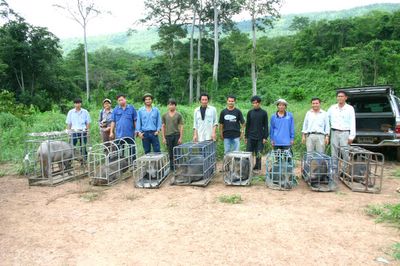
Eight wild boars (7 female and 1 male) are being readied to be released to the wild. Five of the female boars are pregnant with 5-10 babies each. The boars are implanted with microchips for identification. Release of the pregnant boars will ensure better reintroduction results as the boars will have to seek a safe place to have their babies. Also the male boar will be very protective and alert.

Wednesday, September 21, 2005
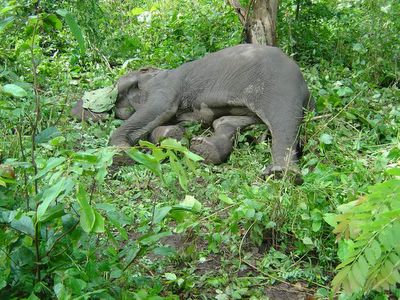
Pang Chumpee is found dead by our field staff in the forest of Doi Phamuang Wildlife Sanctuary near Lampang. She was about 61 years old and died of natural causes. She was released almost 6 years ago by H.M. the Queen Sirikit and enjoyed her last years in the wild after many years of hard work in the logging business. As traditional, a large lotus leaf is used to cover the elephant's face.
Monday, September 19, 2005
Chang, Chierk, and Tua
The Thai language uses two words to differentiate captive elephants and wild elephants. "Chierk" or "rope" is used for captive elephants. "Tua" or "living body" is used for wild elephants. In the past, the number of elephants possessed by a person was symbol of his power and wealth. Since it is usual that wild elephants will mingle with captive elephants, the word "Chierk" or "rope" was used to differentiate the actual number of captive elephants a personage possessed. "Chierk" was the rope that was tied to the captive elephant's ankle, which enabled the mahouts to corral the elephants by tethering another rope to it. I guess that if they had chains in the past, the captive elephants would have been called "Sow" or "chain". Unfortunately, most Thai have been acquainted with captive elephants for so long that the word "Chierk" has been used for both captive and wild elephants. The Elephant Reintroduction Foundation wants to stress the differentiation between "Chierk" and "Tua" and has come up with the motto "From Chierk to Tua".
Royal elephants are called "Chang", since they are regarded as higher than normal animals and cannot be called "Tua" Furthermore, they are not captive elephants and cannot be called "Chierk". ในภาษาไทยลักษณะนาม(บอกจำนวน)ที่ใช้เรียกช้างบ้าน จะเป็น "เชือก" ช้างป่าจะเป็น "ตัว" ในอดีตถ้าใครมีช้างในครอบครองอยู่มาก จะเป็นการบ่งบอกถึงความร่ำรวยและอำนาจบารมี สันนิษฐานว่า คำว่าเชือกจะมาจากการที่ใช้เชือกผูกช้าง และนับจำนวนช้างตามเชือกที่มีซึ่งคำว่า "เชือก" ถูกใช้จนเคยชินจนบางครั้งคนที่ไม่รู้ก็จะเรียกช้างป่าว่าเชือกด้วย มูลนิธิคืนช้างสู่ธรรมชาติจึงอยากจะให้ความสำคัญกับคำว่า "ตัว" จึงมีคำขวัญประจำมูลนิธิฯว่า "เปลี่ยนเชือก เป็นตัว" ส่วนช้างต้น จะมีลักษณะนามว่า "ช้าง"
Sunday, September 18, 2005
Pang Hua Dee has been malnourished and her skeleton shows on her side. Now in Sublanka she will be able to regain her normal weight and beauty. จากภาพสามารถมองเห็นซี่โครงของพังหัวดีอย่างชัดเจน เนื่องจากขาดสารอาหาร แต่เมื่อได้มาอยู่ที่เขตรักษาพันธุ์สัตว์ป่าซับลังกา พังหัวดีก็จะมีอาหารที่หลากหลายให้มีร่างกายที่แข็งแรงสมบูรณ์อีกครั้ง
Tuesday, September 13, 2005
After some convincing, the elephant owner agrees to sell us both the mother and son elephants rather than separating them. Here our Mor Somchai, at the Foundation's office in Chiangmai, hands the owner the cheque for the elephants which we sent by airplane from Bangkok. หลังจากที่ได้อธิบายให้เจ้าของช้างแม่ลูกฟัง เจ้าของช้างตกลงที่จะขายให้กับมูลนิธิฯ เพราะไม่ต้องการแยกลูกกับแม่ออกจากกัน มูลนิธิฯจึงจัดส่งเช็คทางเครื่องบินให้หมอสมชายมอบให้กับเจ้าของช้าง
Friday, September 02, 2005
Pang Hua-dee and her baby son in Chiangmai. Mor Somchai tried to buy both the elephants but the owner said that he had committed to sell him to another buyer. The Elephant Reintroduction Foundation is sad because it doesn't believe that mother and child elephants should be separated until full maturity. It was hoping to be able to buy both and release both to the forest at the same time. หมอสมชาย เข้าติดต่อขอซื้อช้างแม่ลูกจากเจ้าของ ที่จังหวัดเชียงใหม่ แต่เจ้าของบอกว่าได้ตกลงขายให้กับผู้อื่นแล้ว มูลนิธิฯ หวังว่าการเจรจานี้จะทำให้ได้ช้างแม่ลูกเพราะ เราไม่ควรแยกแม่กับลูกช้างออกจากกัน
Subscribe to:
Posts (Atom)









